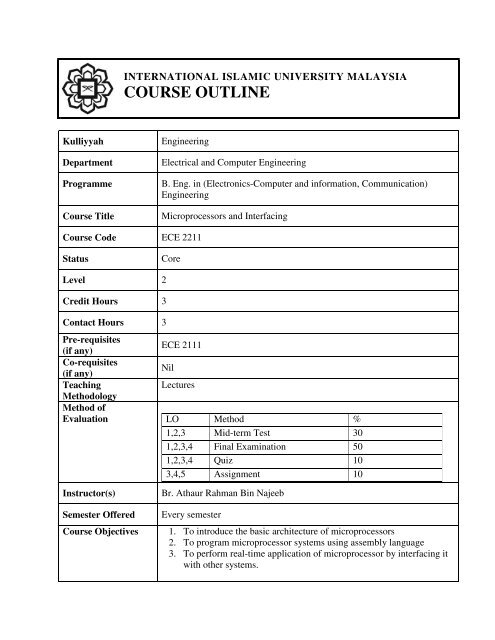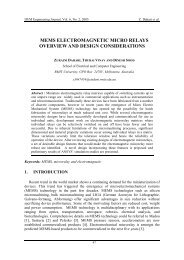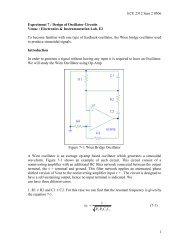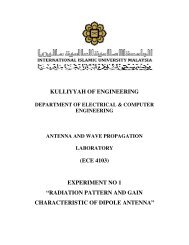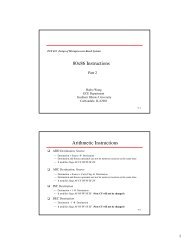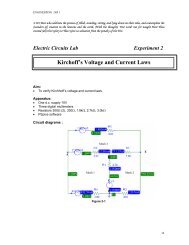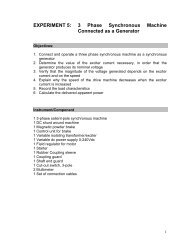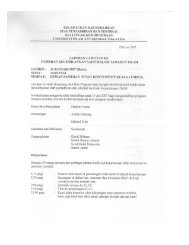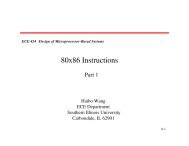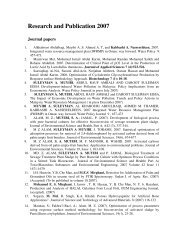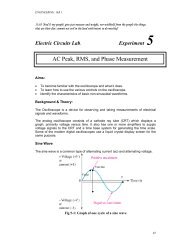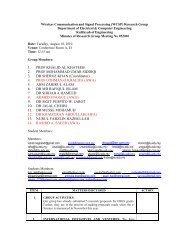COURSE OUTLINE - Kulliyyah of Engineering - International Islamic ...
COURSE OUTLINE - Kulliyyah of Engineering - International Islamic ...
COURSE OUTLINE - Kulliyyah of Engineering - International Islamic ...
Create successful ePaper yourself
Turn your PDF publications into a flip-book with our unique Google optimized e-Paper software.
INTERNATIONAL ISLAMIC UNIVERSITY MALAYSIA<br />
<strong>COURSE</strong> <strong>OUTLINE</strong><br />
<strong>Kulliyyah</strong><br />
Department<br />
Programme<br />
Course Title<br />
<strong>Engineering</strong><br />
Electrical and Computer <strong>Engineering</strong><br />
B. Eng. in (Electronics-Computer and information, Communication)<br />
<strong>Engineering</strong><br />
Microprocessors and Interfacing<br />
Course Code ECE 2211<br />
Status<br />
Core<br />
Level 2<br />
Credit Hours 3<br />
Contact Hours 3<br />
Pre-requisites<br />
(if any)<br />
ECE 2111<br />
Co-requisites<br />
(if any)<br />
Nil<br />
Teaching<br />
Lectures<br />
Methodology<br />
Method <strong>of</strong><br />
Evaluation LO Method %<br />
1,2,3 Mid-term Test 30<br />
1,2,3,4 Final Examination 50<br />
1,2,3,4 Quiz 10<br />
3,4,5 Assignment 10<br />
Instructor(s)<br />
Semester Offered<br />
Course Objectives<br />
Br. Athaur Rahman Bin Najeeb<br />
Every semester<br />
1. To introduce the basic architecture <strong>of</strong> microprocessors<br />
2. To program microprocessor systems using assembly language<br />
3. To perform real-time application <strong>of</strong> microprocessor by interfacing it<br />
with other systems.
Learning Outcomes<br />
Course Synopsis<br />
After completion <strong>of</strong> this course the students will be able to:<br />
1. Identify the internal registers and memory organization for assembly<br />
language programming.<br />
2. Design interface circuits for microprocessors.<br />
3. Develop assembly language codes for microprocessor-based systems.<br />
4. Interface controlling devices and data acquisition systems.<br />
Overview <strong>of</strong> microcomputer architectures and operations, Microprocessor<br />
evolution and internal architecture, Assembly language programming,<br />
Interrupt and interrupt applications, Bus signals and interfacing, Digital<br />
interfacing, Analog interfacing, Direct memory access, Synchronous and<br />
asynchronous serial data communications.<br />
Course Outlines<br />
Weeks<br />
Topics<br />
1 Introduction:<br />
Introduction to microprocessors, General architecture <strong>of</strong><br />
microcomputer system, Evolution <strong>of</strong> Intel microprocessors,<br />
Architectural compatibility, Hardware and s<strong>of</strong>tware, Review <strong>of</strong> the<br />
basic number systems and conversion between different number<br />
systems.<br />
2,3 Basic Architecture <strong>of</strong> the 8088 and 8086 microprocessors:<br />
Internal architecture <strong>of</strong> the 8088/86 microprocessors, Memory<br />
address space and data organization, , Data types, Segment registers<br />
and memory segmentation Pointer and index register, Status and<br />
flag register, The Stack.<br />
Assembly Language Programming:<br />
Addressing Modes.<br />
4, 5, 6 8088/86 Microprocessor – Integer Instructions and<br />
Computations:<br />
Data transfer instructions, Arithmetic instructions, Logic<br />
instructions, Shift and Rotate instructions.<br />
8088/86 Microprocessor instructions – Control Flow<br />
Instructions and Program Structures:<br />
Compare instructions, Jump instructions, Subroutines and<br />
subroutines handling instructions, The Loop and loop handling<br />
instructions, Strings and strings handling instructions.<br />
Reading<br />
Assignment<br />
(Chapter)<br />
1<br />
2<br />
3<br />
5<br />
6
7, 8, 9 8088/86 Microprocessor and their Memory and Input/Output<br />
Interfacing:<br />
Minimum mode and maximum mode systems, Electrical<br />
characteristics, Hardware organization <strong>of</strong> the memory address<br />
space, Memory mapping, Memory control signals, Read and write<br />
bus cycles, Memory interface circuits.<br />
10, 11, 12 8088/86 Microprocessor and their Memory and Input/Output<br />
Interfacing:<br />
Types <strong>of</strong> Input/Output, Isolated and memory mapped Input/Output<br />
interfacing, Input/Output instructions.<br />
Input/Output Interface Circuits and LSI Peripheral Devices:<br />
8255A Programmable Peripheral Interface(PPI), 8255A<br />
Implementation <strong>of</strong> parallel Input/Output Ports, Programmable<br />
interval timer, Programmable direct memory access controller,<br />
Communication interface controllers, Keyboard and display<br />
interface.<br />
13 Stepper motors and ADC:<br />
Stepper motors, Driver circuit design, Interfacing circuit, Program to<br />
control the speed and rotation, Analog to digital converters,<br />
Interfacing and programming, Digital to analog interface.<br />
8<br />
8<br />
10<br />
Recommended<br />
3<br />
(Ch 10)<br />
14 Interrupt interface <strong>of</strong> the 8088/86 Microprocessors:<br />
11<br />
Types <strong>of</strong> interrupt, Interrupt address pointer table, Interrupt<br />
instructions, Enabling/Disabling <strong>of</strong> interrupts, External hardware<br />
interrupt interface, Programmable interrupt controller, Non-mask<br />
able interrupts.<br />
References Required:<br />
Triebel W.A. and Singh A., (2003) The 8088 and 8086 Microprocessors<br />
Programming, Interfacing, S<strong>of</strong>tware, Hardware and Application, 4 th Edition,<br />
Prentice Hall.<br />
Proposed<br />
Start Date<br />
(Semester)<br />
Batch <strong>of</strong><br />
Students to<br />
be Affected<br />
Recommended:<br />
1. Brey, B. B. (1997), The Intel Microprocessors 8086/8088, Architecture,<br />
Programming, and Interfacing, Prentice Hall.<br />
2. Rafiquzzaman, M., (2001), Microprocessors And Microcomputer-Based<br />
System Design, UBS.<br />
3. Ray, A. K. and Bhurchandi, K. M., (2000), Intel Microprocessors<br />
Architecture, Programming and Interfacing, McGraw Hill.<br />
Semester I, 2008-2009<br />
2005 intake and onwards
Course Code and Name<br />
<strong>COURSE</strong> ASSESSMENT MATRIX: ECE2211<br />
Computer and Information <strong>Engineering</strong> Programme Learning Outcomes<br />
NO.<br />
ECE 2211: Microprocessors and Interfacing<br />
1. Identify the internal registers and memory organization for assembly language 3 3 1<br />
programming<br />
2. Design interface circuits for microprocessors. 2 2 2 2 1<br />
3. Develop assembly language codes for microprocessor-based systems. 3 2 2<br />
4. Interface controlling devices and data acquisition systems. 2 2<br />
Outcome 1<br />
Outcome 2<br />
Outcome 3<br />
Outcome 4<br />
Outcome 5<br />
Outcome 6<br />
Outcome 7<br />
Outcome 8<br />
Outcome 9<br />
Outcome 10<br />
Outcome 11<br />
Outcome 12<br />
Outcome 13<br />
Index <strong>of</strong> Computer and Information <strong>Engineering</strong> /Communication Programmes Learning Outcomes<br />
1. The ability to acquire and apply knowledge <strong>of</strong> Mathematics, science and engineering fundamentals.<br />
2. To have acquired a broad based education necessary to understand the impact <strong>of</strong> engineering solutions in a global and societal context.<br />
3. The ability to have in depth understanding and technical competency in Computer and information/ Communication <strong>Engineering</strong>.<br />
4. The ability to undertake problem identification, formulation and solution.<br />
5. The ability to design a system, component or process for operational performance.<br />
6. The ability to design and conduct experiments as well as to analyze and interpret data.<br />
7. The ability to understand the principles <strong>of</strong> sustainable design and development.<br />
8. The ability to effectively communicate orally, in writing and using multimedia tools.<br />
9. The ability to function effectively as an individual and in group with the capacity to be a leader or manager as well as an effective team leader<br />
member.<br />
10. The ability to recognize the need for life long learning and posses the ability to pursue independent learning for pr<strong>of</strong>essional development.<br />
11. The ability to understand the social, cultural, global and environmental responsibilities <strong>of</strong> a pr<strong>of</strong>essional engineer and the need foe sustainable<br />
development.<br />
12. The ability to understand and commit to pr<strong>of</strong>essional and ethical responsibilities.<br />
13. The ability to understand the expectations <strong>of</strong> an engineer who practices in an industrial or governmental organization.


